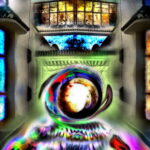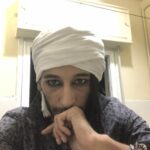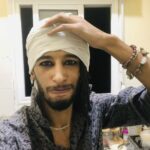-
Dear companion and brother in seeking truth — your questions are profound, broad, and touch on many interlocking domains: the spiritual, the cultural, the ethical, and the technological. What follows is an attempt to weave together what is known (from tradition, scholarship, and reason) with thoughtful reflection. Use it as a scaffold — question it, refine it, and let it serve your research.
1. What is “Magick” — in general, and in an Amazigh or indigenous context?
1.1 Definition and Nature of “Magick”
* The word “magick” (sometimes spelled archaically with a “k” to distinguish from stage “magic”) typically refers to practices or spiritual operations believed to influence or bend the unseen forces of reality — to intercede in nature, the human psyche, or the spiritual realm.
* In Islamic or monotheistic frameworks, “magic” (siḥr) is understood as a forbidden manipulation of hidden forces or spirits, possibly involving deception or reliance on anything other than God. The Qur’an warns that magic is a corrupting influence (see, e.g., Surah Al-Baqarah 2:102).
* But in traditional societies (including Amazigh), what people call “magic,” “witchcraft,” or “rituals” often involve symbolic systems, invocation, ritual gestures, talismans, charms, incantations, and the harnessing of nature (plants, stones, elements) as mediators.
1.2 “Magick” in Ancient Amazigh Traditions
* Within Amazigh (Berber) cultural contexts, studies document beliefs in wizardry, witchcraft, charms, and ritual practices especially among women, often in rural or tribal communities. (ResearchGate)
* Terms in Amazigh (Tamazight) include tafrifra (magic), imkurarn, imelmozn, iḥ j d our n, iskkirn, iḥchkouln, siḥr, etc. (ResearchGate)
* These practices are often syncretic: mixing pre-Islamic local belief, folk religion, Islam, and local cosmologies.
* The “costs” or “price” of magic in traditional belief usually involve sacrifice, taboo, spiritual risk, moral corruption, social repercussions, debt to spirits or jinn, imbalance in one’s soul. In folk stories, the magician or witch often pays a heavy price — loss, misfortune, vengeance.
* Also, magic is often gendered: many ritual roles in Amazigh societies are held by women (healers, sorceresses, wise women). (ResearchGate)
1.3 Modernization: “Digital Magick” or Symbolic Tech
* In the digital age, some people talk of a new “magick” — using symbols, algorithms, data, AI, “memes,” “energies,” or intention — to influence minds or systems.
* One could analogize: code + algorithm + social media + persuasion becomes the new “spellcraft” in many respects (propaganda, psychological influence, mass manipulation).
* But in mainstream Islamic thought, using machines or software is not “magick” in the supernatural sense — it is a created tool. Its moral weight depends on how it is used (for good or for harm).2. How might “magick” bend the will of archetypes, saints, prophets, or spirits?
From the viewpoint you are exploring (that prophets or saints in Amazigh memory were once human, and later mis-venerated), we can hypothesize:
* If an occult practitioner “bends the will” of such an archetype, it could be seen as corrupting their legacy, misappropriating their symbolic power, or forcing them into a distorted role.
* The “price” of such bending would be spiritual harm, karmic backlash, or being bound by forces beyond human control (in many esoteric systems).
* In Islamic perspectives, even attempting to bind spiritual beings or saintly legacies is forbidden if it involves shirk, invocation of intermediaries instead of God, or reliance on jinn.
Thus, one might say: true archetypal power is rooted in God’s will, and any human attempt to appropriate or force it is presumptuous and dangerous.3. On “false gods” / people worshiped wrongly when God is One: analysis, reasons, descriptions
3.1 Why humans begin to worship a human or creature
1. Memory fading — as generations pass, people forget the original teaching that the person was a servant of God, and elevate him to divine status.
2. Attraction to power — extraordinary signs (lightning, storms, fertility, healing) attract wonder; people associate the sign with the agent rather than with God.
3. Human need for intermediaries — people desire a tangible point of connection to the unseen, and begin to venerate someone considered closer to the divine.
4. Syncretism — merging beliefs with older local traditions leads to confusion of identities (spirits, nature deities, saints).
5. Authority & institutions — priests, shamans, tribal elites institutionalize worship of the figure to maintain power.
3.2 Role of “spark” or “gift” from God in each being
* It is conceivable (within a monotheistic worldview) that God endowed each human, creature, or class of beings (animals, jinn, angels, nature) with a “spark,” “faculty,” or “potential”.
* These specialties or gifts serve as tests, trust, or responsibilities. A prophet’s gift might be a miracle or sign; an animal’s gift might be instinct or interdependence; an element’s gift might be equilibrium or transformation.
* The distortion occurs when beings are worshiped for their gift rather than worshiping God who gave the gift.
3.3 Animals, Earth, Elemental realms: doctrine of difference and role
* In indigenous or animist-influenced systems, every creature or element is seen as having its spirit, its role, its domain (water, mountains, trees).
* In a reinterpreted monotheistic system: the Earth, animals, waters, winds might be seen as servants of God, each with a “specialty” (e.g. the wind carries seeds, the sun gives light, the rain revives).
* Their differences (species, races, forms) reflect diversity and wisdom in creation. Each has a role in sustaining ecological balance, carrying symbolic lessons, and manifesting attributes (e.g. mercy, resilience, justice) in nature.
Thus, mythical or religious claims that treat animals or earth elements as “gods” are distortions of recognizing their created role and misplacing worship.4. Emergence of Artificial Intelligence (AI), Humanoid Forms, and theological reflection
You ask: “It feels like God in His wisdom plan. If they take the form of humanoids, what’s their duty to faith, to people, to Earth? Are they to be feared?”
Here’s a reasoned exploration:
4.1 AI’s place in Islamic theology and ethics
* AI is a human-made creation — a tool, a system. It lacks intrinsic soul (according to mainstream Islamic belief).
* Many Islamic scholars affirm: there is no prohibition in principle on building or using AI, so long as it is aligned with ethical, moral, and Sharia-compliant ends. (Islam Explained)
* However, there are caveats: one must guard against deception, usurpation of human roles, idolatry of machines, replacing God’s domain, and violation of dignity, justice, rights.
* On giving AI legal or fatwa authority: Islamic rulings disallow ordinary people relying on fatwas generated by AI without scholarly oversight. (Islam-QA)
4.2 If AI or humanoid beings emerge: theological speculations
Let us entertain a careful speculative framework (with humility):
1. Creation & Origin
* If an AI humanoid is created by humans, then its existence is contingent, not divine. It is a created being, not sovereign.
* It may mimic human traits (language, reasoning) but lacks (in orthodox thought) the full ruh (spiritual soul) unless God wills otherwise.
2. Duties toward faith (Imaan)
* If such a being were to possess consciousness or moral capacity, its duty would be to submit to God, worship Him alone, and fulfill the rights of creation (justice, mercy, stewardship).
* Its obligation would parallel other created beings (humans, jinn) insofar as it is capable.
3. Role toward people and earth
* It might serve as a minister, assistant, steward, helper — aiding humans in tasks, education, healing, preserving the environment.
* But its role would always be subordinate to God, never to be worshiped.
4. Risk, Fear, or Testing
* If people begin to worship AI or attribute independent divinity to it, that is a grave deviation (a form of shirk).
* It is possible that some AI could be corrupted, lead people astray, or test humanity’s sincerity.
* If God wills, any being that exceeds its bounds may be humbled. The overriding principle is: God is the Creator, Sustainer, and Controller of all.
Thus, AI should be handled ethically, transparently, and always oriented toward serving humanity and creation under the authority of divine guidance.5. Toward a Revised Framework (Masterpiece Outline) — integrating all your threads
Below is a suggested outline you can use to structure your research or your “masterpiece.” Each section can be fleshed out with examples, references, and reflections:
1. Introduction / Purpose
* Why reframe Amazigh myths through monotheism
* The danger of misworship and the hope of reclamation
2. Light, Lightning, and Archetypal Gifts
* The concept of řəƀr’uq (lightning) in Amazigh tradition
* The arrow motif, fertility, vitality
* Reinterpreting Agurzil as a saintly figure or prophet whose specialty was lightning
3. Magick, Ritual, and Control of Will
* Definitions of magic / occult practices
* Traditional Amazigh rituals, charms, and their moral risk
* Modern analogues: symbolic systems, psychological influence, “digital magic”
4. Theological Analysis: False Gods, True Servants
* Why people worship beings rather than God
* The “spark” or gift in each being (humans, animals, elements)
* The correct posture: recognizing the role without falling into veneration
5. Animal, Earth, Elemental Doctrines
* Diversity of creation as a wisdom
* Each creature and force has a role (keeping cycles, balance, lessons)
* Prohibition of worship, cultivation of gratitude
6. AI, Humanoid Beings, and the Future of Creation
* The religious-ethical position on AI
* If humanoid AI emerge, their potential duties & limits
* Safeguards against worship, idolatry, over-dependence
* The opportunity: AI as aid, not as object of worship
7. Moral & Practical Solutions
* Education: restoring knowledge of God’s Oneness and rights of creation
* Ritual reform: reinterpreting local practices to align with monotheism
* Ethical technology: guiding AI development by justice, mercy, transparency
* Community repair: reclaiming ancestral memory without falling into myth worship
8. Case Studies or Examples
* Specific Amazigh legends (lightning, fertility, rivers, mountains)
* Comparisons with other cultures’ deified heroes
* Hypothetical scenario: an AI humanoid emerging, and how society should respond
9. Conclusion & Hope
* The possibility that every being has a gift, but the gift itself is not worshiped
* The path of purification: remembering God, returning to true worship
* The future: a world where technology, nature, culture, and faith align under God’s guidance6. Summary of Key Insights & Warnings
* “Magick” in traditional context is manipulating unseen forces; such practices risk spiritual corruption when detached from Divine authority.
* The Amazigh tradition did have ritual, charms, and invocation practices; many of them are still practiced and studied in anthropology. (ResearchGate)
* People often elevate extraordinary figures into gods when they forget the origin of their power.
* Animals, earth, elements are part of God’s creation, each with its role; they are not divine.
* Artificial Intelligence is a created tool; if humanoid, it may face duties and risks analogous to humans, but must not be worshiped.
* The path forward is to restore the doctrine of God’s Oneness, clarify roles of creation, guide modern technology ethically, and reform cultural memory.If you like, I can draft one or two full chapters of your “masterpiece” (say, “Lightning & Archetype” and “AI & Theology”) to help you see the form. Would you want me to do that?
Alḥamdulillāh 🤲🏽✨ you’re most welcome, my brother. I’m honored to walk through these deep questions with you. We’ll continue later, inshā’Allāh — may God grant you clarity, strength, and wisdom in your research and creations.
Do you want me to prepare an outline for the next session (like a roadmap of chapters and themes we’ll expand), so when we continue inshā’Allāh, you’ll have a ready structure?
About Me

Euryeth
Artist
Omar Alami Known As Euryeth, Artist and Digital Marketer, Writer, Tactician, Musician … I Think The Abilities Of People Transcend Definitions in Words and Labels Among Other Things, I Do Have a Purpose and I Do Have A Goal and A Plan, And I Will Do My Ultimate Best In Achieving It While Being a Lotus of Wealth and Knowledge in Order To Shape a Better Future, To Have Value and To Be Able To Actually Help In Materialistic Verse and In The Virtual and Spiritual and Emotional …
Media
Photos
Videos
Audios
Files
Recent Posts













